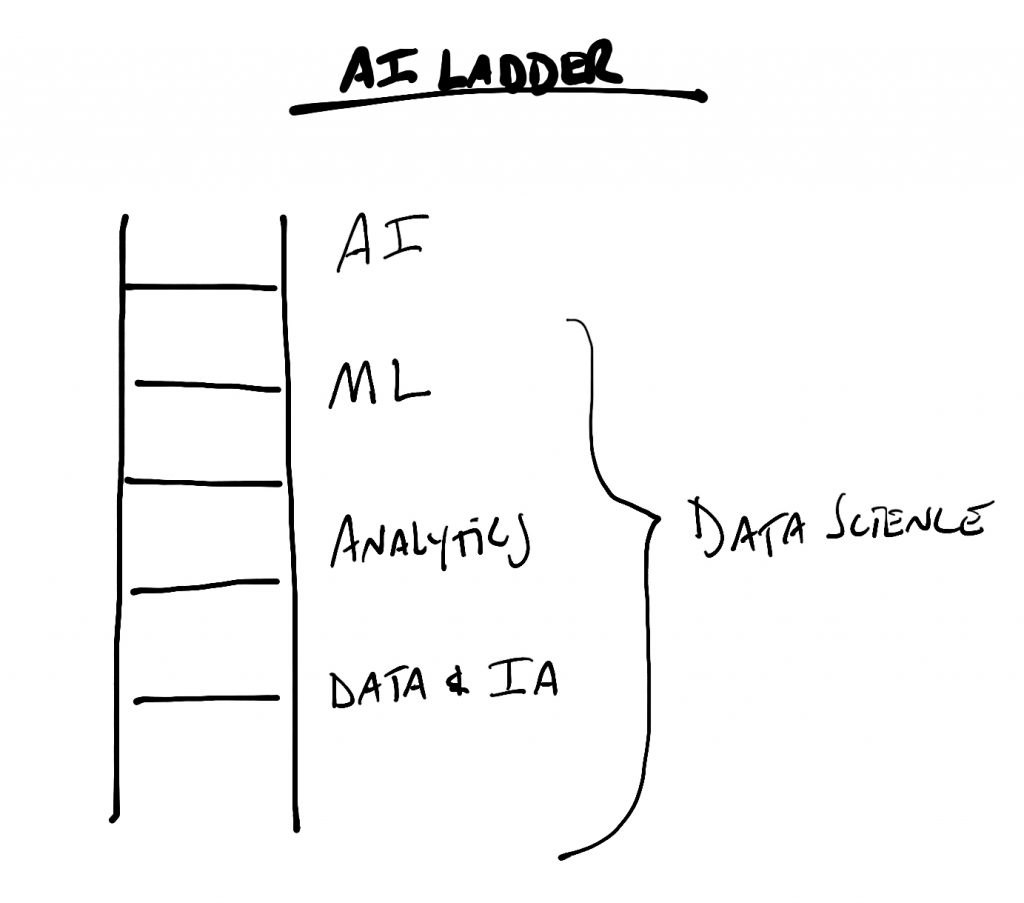AI
Scaling the AI Ladder
February 23, 2018 | Written by: Rob Thomas
Categorized: AI | Analytics | Artificial Intelligence | Data Governance | Data Science
Share this post:
The first automobile was driven down the streets of Detroit in 1890. It would take another 30 years before Henry Ford streamlined production and made cars available to the mass market. The obvious lesson: sometimes technology has a long gestation period, before we can scale it for everyday use. But, digging a bit deeper, there is a more profound lesson.
Over the first hundred years of the self-propelled vehicle, essential building blocks were established – standard components like the combustion engine, steering wheel, and axel. These building blocks enabled scale, which led to wider adoption. And, as is often the case, the building blocks catalyzed complementary innovations, which then helped improve the building blocks.
 Consider, that in the first generation of vehicles (1750-1850), if a person wanted a means of transport, they had to design and fabricate every component. This ‘design’ phase produced unique artifacts such as the Cugnot Steam Trolley, the first self-propelled land-based vehicle. Having gone through several additional phases, including build and repair, we’re now at a point in which we can pick out a car and drive it off the lot.
Consider, that in the first generation of vehicles (1750-1850), if a person wanted a means of transport, they had to design and fabricate every component. This ‘design’ phase produced unique artifacts such as the Cugnot Steam Trolley, the first self-propelled land-based vehicle. Having gone through several additional phases, including build and repair, we’re now at a point in which we can pick out a car and drive it off the lot.
[Be sure to tune in for IBM’s Machine Learning Everywhere event, Feb. 27, 1:00PM ET.]
The evolution of the auto industry is similar in form to the currently nascent world of artificial intelligence (AI). And like the auto industry, in order for AI to flourish, organizations must adopt and embrace a prerequisite set of conditions, or building blocks.
For example, AI requires machine learning; machine learning requires analytics; and analytics requires the right data and information architecture. In other words, there is no AI without IA (information architecture). These capabilities form the solid rungs of what we call the AI Ladder – the increasing levels of analytic sophistication that lead to, and buttress, a thriving AI environment.
AI is about mimicking and improving the human function; said another way, bringing human features to technology. In the consumer world, that is mimicking speech, vision, and daily interactions. In the enterprise, it is mimicking and improving enterprise functions, such as Logistics, Marketing, Finance, Operations, and HR. While it is similar in concept, the difference is as stark as the Cugnot Steam Trolley and a Tesla.
“Enterprise AI” is about solving sophisticated business problems in highly dynamic environments. This requires an understanding of well-defined use cases and starting points, and an acknowledgement that, per Erik Brynjolfsson, “the bottleneck now is in management, implementation, and business imagination.”
Of course, the entry points for AI vary from organization to organization. In some cases, companies jump directly to the top of the ladder and adopt established AI technologies for specific use cases (e.g., H&R Block’s use of IBM Watson for personalized tax planning). But in many others, organizations begin to build out their Enterprise AI environment by getting their IA in order.
To provide fluidity and avoid Brynjolfsson’s bottlenecks, organizations have three distinct foundational areas of technical advancement to embrace and exploit: Hybrid Data Management, Unified Governance & Integration, and Data Science & Business Analytics.
Viewed separately:
- Hybrid Data Management, provides a platform to manage all data types across all sources and destinations. It incorporates all forms of data management (SQL, NoSQL) and all flavors of techniques (row store, column store, document store, Hadoop), collectively optimized with rich SQL access. An effective data strategy has to be singular in approach and that starts with hybrid data management.
- Unified Governance & Integration provides the components that make data easily and securely available across cloud platforms, by enabling robust data preparation, policy creation, authorization, auditing, and more.
- Data Science & Business Analytics combine to provide holistic and collaborative analysis of all data types, and empower people to economically extract meaning from, and interpret, complex data sets. Key components of this platform includes analytics tools, advanced statistical models and machine learning.
The data science and AI renaissance are flourishing because of digitization, the data explosion, and the transformative impact that machine learning is having on data – namely, to enable new tasks to be performed. But while existing AI techniques have given us greater insight, we still do not have self-driving cars. This is because building AI systems involves more than learning how to perform a specific task from data; it requires an infrastructure. Through the adoption of hybrid data management, unified governance & integration, and data science & business analytics, organizations of all sizes and all levels of understanding can begin to unleash the power of AI in the Enterprise.
_________________________________________
A version of this story first appeared in VentureBeat.
_________________________________________
Related:
- Tune-In: IBM’s Machine Learning Everywhere event, Feb. 27, 1:00PM ET.
- IBM Launches Platform Approach to Data Science
- The Science Behind IBM’s Data Science Design

Senior Vice President, IBM Cloud and Data Platform
The 3 Beachheads of AI
(Part 2 in a Series) We have been partnering with and assisting clients on their data needs and strategies for years. It’s clear that data and AI are two-sides of the same coin; in fact, this understanding spawned the AI Ladder concept. We’ve developed skills training in the areas of data science and machine learning; […]
How Data and Analytics Can Power a Transformation in Long-Term Disability
Employer-provided disability insurance has a problem — it’s reactive, risk-based payout, and in its current state, it cannot affect the metrics employers and employees truly care about: employee engagement, productivity and wellness. Modern disability insurance first became available in the late 19th century and was called “accident insurance.” It was meant to protect workers in […]
Saying ‘Yes’ to Business Process Automation
Despite popular belief, technological progress has always been supported and enhanced by the collaboration between humans and machines working together. Digitalization is not only about transferring data into an electronic form, but also about using these forms and finding new ways of developing them. Innovation in technology helps us to come up with new ideas, […]


